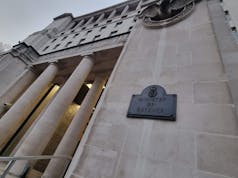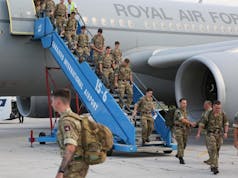Defence Secretary Gavin Williamson has allocated £11 million of additional funding to bolster the UK’s response to chemical attacks, say the MoD.
According to a release, the range of measures announced by the Defence Secretary include:
- Developing plans to deploy drones and robots into potentially hazardous areas, putting personnel in less danger and identifying threats faster.
- Boosting the Defence Science and Technology Laboratory’s ability to analyse substances, by investing in new technical capabilities.
- Keeping the UK at the forefront of medical advances to combat the effects of chemical agents.
“Unmanned vehicles will conduct more testing and identification, decreasing the risk posed to humans through contact with nerve agents. This capability will be developed over the coming years.
The funding will increase the speed and accuracy with which the potential origins of substances can be analysed, helping the authorities identifying attackers faster and improving public safety. It will also allow faster decontamination and recovery of vehicles and assets, as well as improvements to counter radiological and nuclear threats.”
Defence Secretary Gavin Williamson said:
“After the Novichok attack in Salisbury a year ago, the nation turned to the Armed Forces and expert scientists. From the investigation to the clean-up, the military and everyone involved in the operation have worked tirelessly to decontaminate the streets of Salisbury.
Britain and its allies have also demonstrated that they will take a stand against the use of chemical weapons, from the sanctions enforced on Russia following the reckless use of Novichok to the strikes against the chemicals used by Syrian regime. We recognise we need resilience to face evolving threats which is why we have invested £11 million into ensuring we have a world-leading capability.”
Standing Joint Commander (UK) Lieutenant General Tyrone Urch said
“The decontamination work in Salisbury and Amesbury over the last 12 months has been a complex and daunting challenge for the Armed Forces. All of the personnel involved demonstrated adaptability, professionalism, resilience and courage; they have been absolutely first-class and lived up to their world-leading reputation. This investment will allow us to further improve our expertise and, most importantly, keep the public safe.”













While welcome, this does come across as another announcement full of hot air and not a lot else.
£11 million defence wise is chicken feed.
The DSTL Counter Terrorism Science and Technology Centre already has world leading expertise, most of which remains classified, and they are always researching new techniques. So this is nothing new, just more PR grandstanding.
The drones and robots, will be interesting to see what emerges. I imagine they are beyond the Wheelbarrow or whatever the RE and RLC people have used for EOD and IED work, and can operate over rough terrain, flt through small gaps, through open doors and windows, etc.
Totally.
The UK are already world leading in the field and ironically Porton Down was a few miles to the east! Our services dealt with the incident and the intelligence services traced the culprits ( if you believe that )
So the whole issue being in the public consciousness they will be keen to push the point at what HMG are doing to improve further.
Porton Down being close to Salisbury seems to be the Russian narrative that the novichoks came from there and that the attack was instigated by the UK goverment lol!!!
It’s interesting but I’ve seen this before, post 9/11 we had a bit of a go at civil defence. We got a pallet of decontamination equipment ( tent and suits etc), detection equipment for nuclear isotopes, pods of emergency drugs for nuclear/chemical attacks and training on suiting up, decontamination and treating contaminated patients.
Trouble is the training was not sustained. When you are talking about managing such high risk patients it really needs to have ongoing updates and practice with the kit/process and this did not happen.
The langsley reforms in the NHS also changed how the NHS priorities civil contingency and removed the Key planner and purchaser of care/hospital provision from having responsibilities for civil contingency ( the mistake was realised and CCGs are being asked to do more and we have re started incident rooms and ensured we have retrained incident room staff and incident managers), but without any budget…..
What we need is a root and branch review of civil defence and continued year on year investment and training. As an NHS incident room manager I do it on a volunteer basis and have to ask to get time back from my boss ( Last year during the beast from the east I was up all night after a full day of work managing the local incident room sorting out transport systems, without pay).
Hmmm.
I also recall after 9/11 or that sort of time frame the 14 TA Infantry Battalions were earmarked as Civil Contingency Reaction Forces.
I have no idea how much training for that happens now. I’ve not even read that term from the MoD concerning those formations since.
Politics!
It was 2 deaths so far (the Russian ex-spy himself and the wife of the couple who found the discarded perfume bottle). In any event, isn’t this more about “what if this were to happen again” than “this is what happened”?
The Salisbury incident was apparently a targeted attack against a single intended victim using a very localised distribution mechanism (a door handle). If some group had the objective of mass casualties rather than a single assassination and used such weapons with a more aggressive dispersal method the casualties would almost certainly be far higher than 2.
There’s a lot of defence spending justified on what might happen not on what has happened although what has happened can sometimes act as a wake up call for what might happen. Phalanx has never saved an RN ship hence never saved a single UK life (as far as I am aware) and yet we still install them (on too few ships due to the fit-for-specific-deployments policy for RFA vessels – to the annoyance of many here).
This does seem like a pretty small sum of money though but anything is welcome. It presumably at least buys some fancy new analysis equipment additions and/or upgrades at Porton Down, maybe some computer upgrades, and makes sure that no key science staff positions will be cut. Plus buying a few extra drones, the budget must surely only cover existing products not any new design there.
I know for a fact The London Regiment (Reserves) train for NBC, or should I say CBRN, and is part of the CCRF for London. Although I’ve heard that their job in a major crisis would be the extraction of the dead and seriously wounded from contaminated areas.
I know for a fact The London Regiment (Reserves) train for NBC, or should I say CBRN, and is part of the CCRF for London. Although I’ve heard that their job in a major crisis would be the extraction of the dead and seriously wounded from contaminated areas.
Yes have been the reserve for years for CBRN. Not sure it is the whole Regiment or one of the component Squadrons…Duke of Westminster or something I forget.
Interesting the CCRF title still in use.
Interestingly the NHS CBRN PRPS (see what I did there, 11 words down to an 11 letter string) which we got after 9/11 all have a 10 year life cycle and have recently been replaced. With an increase in numbers with the reprocurement from each trust maintaining 12 suits to 24. That’s actual a pretty big investment when you count how many hospitals we have.
This reprocurement started before sailsbury as well.
For the geeky the suits are made by respires international from Tychem TK with an M3 Jupiter air filter unit with externally mounted 3M TH3 A2B2E2K2P R filters which have enhanced protection against chemical and biological warfare agents, it has a waist mounted battery, remote warning indicator device with three colours at chin level, large semi rigid visor bonded to the suit, integral safety boots with steelies, dual glove system including laminated inner gloves fixed to the suit with a respires locking cone and grommet, hydration facility and exterior attachment point for a distress signal unit….
Which is way better that the PRPS I got trained in ( going up and down stairs without killing yourself was a major part of the training, o yes and taking it off, that was an iffy bit as well)
The NHSE EPRR for chemical incidents and is a thrilling read and gives a good overview of what you need in place to manage major chemical incidents and NHSE EPRR guidance for the initial management of self presenters from incidents involving hazardous materials, NHS IOR training Video are some great sets of open source information on CBRN management.